Total relics are approximately 32,000 items including not less than 10,000 items from excavation of burial cultural properties that were excavated from historic sites at Deokcheon-dong, Nopo-dong, old tombs, Gimhaeeupseong in Busan, Gyeongnam area, about 10,000 purchased items, about 8,000 items of donation, about 360 collected items. At present, 1,500 items of History and Folk customs of Busan from the Prehistoric period to the present (till in1953) are mainly displayed. About 40 stone-built items such as pagoda, Buddhist statues, tombstones, etc. are displayed at the outdoor exhibition space.
A total of 19 posts. (2/2page)
-
Busan Metropolitan City-designated Monument No. 84
-
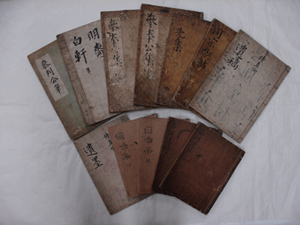
- They are the old books and documents of the family of Bangok, LEE DEOK-SEONG, who greatly influenced the society of Joseon Dynasty, from the middle years to latter period thereof, both in education and arts. The most typical remains includes the [Baekheon-Pilcheop] of LEE GYEONG-SEOK, great grandfather of LEE DEOK-SEONG, the [Champan-Gongjip] of LEE HU-YEONG>, father of LEE DEOK-SEONG, the [Sijikgong-Yumuk] of LEE JIN-WON, the first son of LEE DEOK-SEONG, the [Seonjip] and [Chambong-Gongjip] of LEE GWANG-RYEO, a grandson of LEE DEOK-SEONG, the [Wongyojip] of LEE GWANG-SA, a great grandson of LEE DEOK-SEONG and the [Daeyeon-Yugo] of LEE MYEON-BAEK, a great-great grandson of LEE DEOK-SEONG’s third cousin, etc. As the books were written in an excellent handwriting, most of which are the only copy of manuscript, they are important materials in the study in the science of bibliography, Korean literature, ancient art history, etc. At present, the books are exhibited in the Donation Center of Busan Municipal Museum.
-
Eojeonjuncheonjemyeongcheop
-
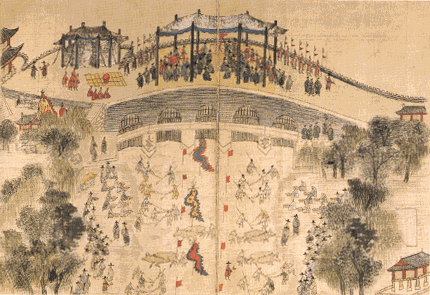
- This is a scrapbook of painting and writings in commemoration of the cleaning and repairing work of brook(Today’s Cheonggyecheon in Seoul), which was done in the 36th year of King Yeongjo(1760). The scrapbook includes Juncheonsojwamok(a book containing the names of both the officials of the Juncheonso and the manpower mobilized for the cleaning and repairing work), 2 pieces of drawings(Sumunsangchinrimgwanyeokdo and Yeonghwadangchinrimsaseondo), the theme of a poem shown by the King himself at the site, and the poems of the King’s men who answered in response to such theme.
-
Haengseodaeryeon
-
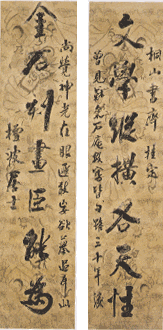
- This is a rhyming couplet written by the Chusa, Kim Jeong-Hee, famous as a talented man in painting and writing, in the latter-half years of Joseon Dynasty. Through the content of the writing, we can see one side of Chusa who established the school of epigraphy of Joseon by making much effort to study the epigraphy and search and protect the data related to epigraphy as well as by teaching his younger scholars.
-
Earthenware in the shape of shoes in Bokcheondong Ancient Tombs
-
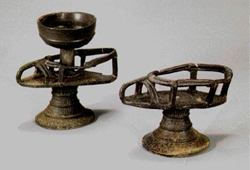
- This was earthenware excavated from the wooden box in Bokcheon-dong No.53 tomb of the middle years of 5C, an earthenware in the shape of footwear adhered to Daegak. This earthenware is a kind of dish decorated with leather shoes, to which are adhered several legs. It is a material through which we can find out the footwear culture of the people at that time.
-
Baekjacheolhwayongmun Jar(White porcelain jar with design of dragon)
-
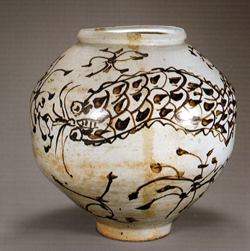
- This jar was a large white porcelain jar in the middle years of Joseon Dynasty, which was used at home to keep therein salted crabs and shrimps. Dragon and vine design was drawn on its surface using iron oxide paintings. Though its design, of which dragon looked like a centipede, was abstract, its strokes of brush was very lively and humorous, showing the peculiar characteristics of the local products, distinct from those produced by the central official manufacturers in Gwangju.
-
Busan Metropolitan City-designated Monument No.18 and 19
-
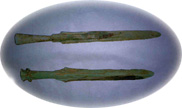
- Dongmo(bronze spear) is one of the typical remains as well as Donggeom(bronze dagger) and Donggwa(bronze spear with branch). It was made using the formwork made of stone and generally consisted of two (2) parts, spearhead and handle sheath, which was used to pierce an enemy by inserting a long wooden handle into the handle sheath. Dongmo is excavated together with thin a type of Donggeom, Donggwa and Dongbu(bronze ax) and sometimes together with ironware. It lasted until about B.C. 2C to the end of B.C. 1C, and seems to have been completely replaced by ironware after then. Like these remains, the spearhead and handle sheath got long and the spearhead got wide. I think this was the process the bronze ware of Korea was getting to be used in ceremonies. At present, Dongmo is preserved and exhibited in the Bokcheon Annex Building of the Municipal Museum.
-
Portrait of Yi Deok-seong and Related Relics (Treasure No. 1501)
-

- This includes 121 items of remains related to Bangok, YI DEOK-SEONG, a civil minister during king Sukjong in Joseon Dynasty, including [Baekpae], [Hongpae], [Gyoseo], [Yuseo], [Gyoji], [Gyocheop], [Sigwon], [Jauidaebiokchaek], [Bongraebyeoljangcheop], [Heonreungdaewangsindobimyeong], etc. in addition to the portrait of YI DEOK-SEONG The portrait of YI DEOK-SEONG, the most typical remain out of the above mentioned, is his true image when he was 42 years old, an appearance of a vassal of merit in early 18C, which is an important example in the study of the portraits at that time. In the meanwhile, the 『Jauidaebiokchaek』, which had been damaged in the fire of Mansujeon in 1687(13th year of King Sukjong), was recently restored by YI DEOK-SEONG. The 『 Bongraebyeoljangcheop (Geon•Gon)』is a collection of works of letter writings consisting of congratulatory and encouragement letters sent by many people like top government officials, officials, writers and relatives. At present, they are exhibited both in Joseon Room and in the Donation Center of Busan Museum.
-
Sansuinmuldo(Landscape and Figure Painting)
-
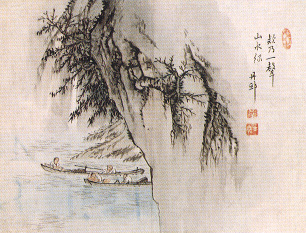
- This is a painting drawn by Danwon, Kim Hong-Do, one of the typical painters in the latter-half years of Joseon Dynasty, which seems to be a piece drawn by him when he was older than 60 judging from the characteristic of painting style. Together with Hyewon, Sin Yun-Bok, Danwon is known to us as a typical genre painter in the latter-half years of Joseon Dynasty.
-
Busan Metropolitan City-designated Monument No. 20
-
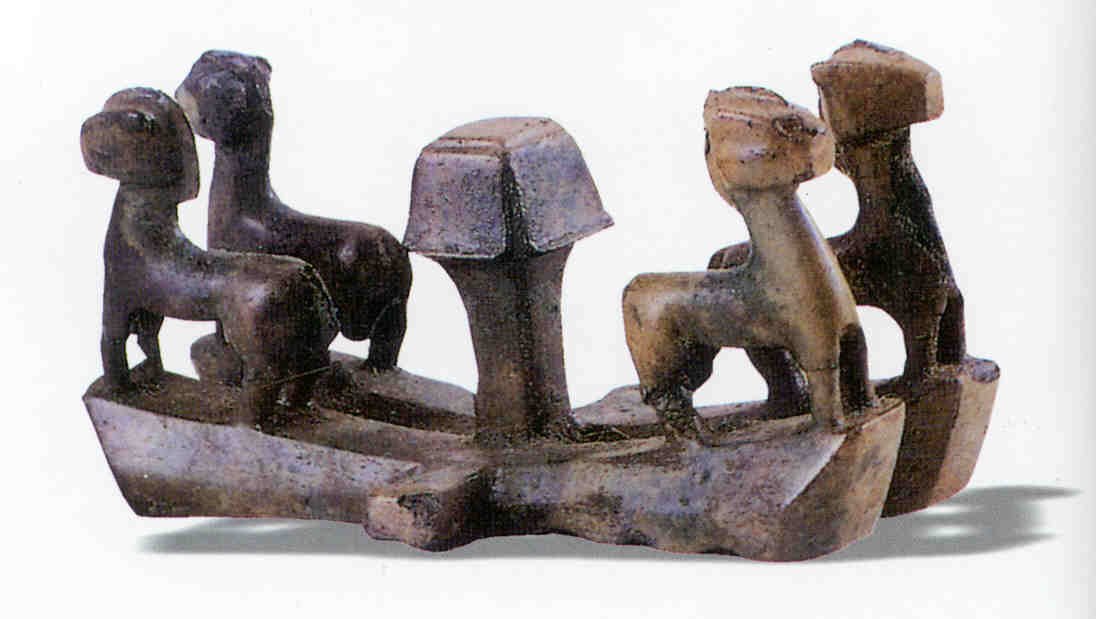
- Padu is a kind of decoration that is adhered to the end of handle either of bronze dagger or of iron dagger, of which material is various, including stone, bronze, earth, etc., but the ones made of bronze are being found most. While the four(4) horses are modest, the point of shape are well expressed, harmonized with the form and size of the knob in the shape of square column. And as the bronze rust in yellowish green color developed on its surface, it gives out a beautiful gloss like a jade. The era of Padu is estimated to be around A.D. 1C, and it is an important material to find out the aspect of Metal Culture in the early period of our country.At present, Padu is preserved and exhibited in the Bokcheon Annex Building of the Municipal Museum.